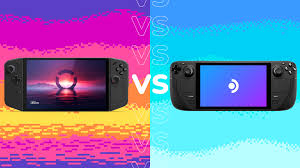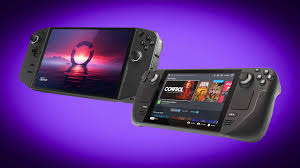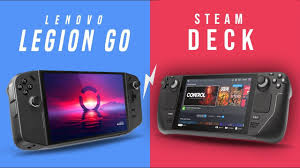So you’re in the market for a handheld gaming device and stuck between two of the biggest names right now: the Lenovo Legion Go and the Steam Deck. Totally understandable—they’re both awesome, but they’re also very different in what they bring to the table. If you’re a casual gamer who just wants to relax on the couch or someone who loves diving into heavy AAA titles on the go, this guide is here to help you figure out which one fits your style better.
In this comparison, we’ll walk you through everything that matters—performance, display, controls, battery life, price, and more—all in simple words and real-world terms. No tech jargon. Just straight-up answers to help you decide.
Related: PS5 Slim Vs Xbox Series X – Which Gaming Console is Best?
Specs
| Feature | Lenovo Legion Go | Steam Deck |
|---|---|---|
| Processor (CPU) | AMD Ryzen Z1 Extreme (8-core, 16-thread, up to 5.1GHz) | Custom AMD APU (Zen 2, 4-core, 8-thread, up to 3.5GHz) |
| GPU | AMD RDNA 3 Graphics (12 Compute Units) | AMD RDNA 2 GPU (8 Compute Units) |
| RAM | 16GB LPDDR5X @ 7500MHz | 16GB LPDDR5 @ 5500MHz |
| Storage Options | 512GB / 1TB PCIe Gen4 SSD (User-replaceable) | 64GB eMMC / 256GB NVMe / 512GB NVMe SSD |
| Display | 8.8-inch QHD+ (2560 x 1600), IPS, 144Hz | 7-inch HD (1280 x 800), LCD, 60Hz |
| Touchscreen | Yes | Yes |
| Refresh Rate | 144Hz (variable) | 60Hz |
| Operating System | Windows 11 Home | SteamOS 3.0 (Linux-based) |
| Controls | Detachable Legion TrueStrike Controllers | Integrated Controls + Touchpads |
| Connectivity | Wi-Fi 6E, Bluetooth 5.2, USB-C with DisplayPort 1.4 | Wi-Fi 5, Bluetooth 5.0, USB-C with DisplayPort 1.4 |
| Battery | 49.2Wh (2-4 hours gameplay) | 40Wh (2-4 hours gameplay) |
| Charging | 65W USB-C PD Fast Charging | 45W USB-C PD Charging |
| Weight | ~854g (1.88 lbs) | ~669g (1.47 lbs) |
| Dimensions | 11.8 x 5.16 x 0.86 inches | 11.7 x 4.6 x 1.9 inches |
| Expansion Slot | microSD card slot | microSD card slot |
| Kickstand | Yes | No |
| Price Range | Starts around $699–$749 USD | Starts at $399 USD (64GB model), $649 USD (512GB) |
How Powerful Are They?
If you care about raw power—like how well games run, how smooth they look, and whether you can crank up the graphics—then the Lenovo Legion Go is the stronger of the two. It runs on AMD’s Ryzen Z1 Extreme chip, which is super fast and designed for heavy gaming. This thing can easily handle demanding titles like Cyberpunk 2077 or Starfield, especially if you tweak the settings a bit. It also has 16GB of speedy RAM and fast SSD storage, which means quicker loading times and less waiting around.
On the other hand, the Steam Deck comes with a custom AMD chip that’s not as strong as the Legion Go’s but still does a solid job. It runs most games really well, especially if you’re okay with medium graphics settings. Thanks to its software, it gets the most out of the hardware without wasting energy or speed.
If you’re after maximum performance, go with the Legion Go. But if you’re happy with solid gameplay and good efficiency, the Steam Deck won’t disappoint.

Which One Has the Better Screen?
The Legion Go really shines in this area. It comes with a huge 8.8-inch display with a super sharp resolution (QHD+) and a smooth 144Hz refresh rate. That means games look crisp and run smoothly, especially fast-paced ones. Colors are vibrant, details are clear, and the screen just feels premium.
The Steam Deck, especially the newer OLED version, also offers a great viewing experience. While it’s smaller at 7.4 inches and doesn’t have as high a resolution, the OLED screen brings deeper blacks, richer colors, and supports HDR for a more cinematic feel. Plus, it uses less battery compared to the Legion Go’s high-res screen.
If you want big, bright, and buttery-smooth visuals, the Legion Go is your guy. But if you’re okay with a slightly smaller screen that looks amazing and helps your battery last longer, the Steam Deck OLED is a solid choice.
Related: Best Laptop For Sketchup and Autocad 2024
How Comfortable Are They to Use?
The Steam Deck wins when it comes to comfort and grip. It’s lighter (669g vs Legion Go’s 854g) and has a more ergonomic design, so it feels easier to hold during long gaming sessions. Everything is built into one solid piece, and it has useful extras like built-in trackpads for better mouse-like control—great for strategy or PC-style games.
The Legion Go, meanwhile, is chunkier and heavier, but it has detachable controllers similar to a Nintendo Switch. This makes it super versatile. One of the coolest features? The right controller doubles as a mouse with a built-in sensor and scroll wheel. Great if you play a lot of shooters or want to use it at a desk. But just be ready for the added weight if you plan to play for hours handheld.
If comfort is your top priority, the Steam Deck is easier on your hands. If you like extra control options and a Switch-style setup, the Legion Go offers more flexibility.
What’s the Software Like?
This is a big difference between the two. The Legion Go runs Windows 11, which means you can install just about anything—Steam, Xbox Game Pass, Epic Games, GOG, emulators—you name it. You basically have a full PC in your hands. But Windows isn’t built for handheld use, so sometimes navigating menus or switching games can feel a little awkward.
The Steam Deck runs SteamOS, a custom system built just for gaming. It’s clean, fast, and super easy to use. Boot it up, pick a game from your Steam library, and play—it really is that simple. You can still install other platforms if you want, but it’s more of a “techy” process.
If you love tweaking settings and having full freedom, the Legion Go gives you that. But if you want something that “just works,” the Steam Deck nails the experience.
How Long Does the Battery Last?
Battery life is always a concern with handhelds. The Steam Deck does better here, especially the OLED model, which is more efficient. Depending on what you’re playing, you can get anywhere from 2 to 8 hours of use. Lighter indie games will last longer, but expect 2–3 hours for demanding titles.
The Legion Go, because of its bigger screen and higher resolution, uses more power. On average, it’ll last 1.5 to 4 hours depending on how you play. It does support fast charging though, which helps when you’re in a hurry.
So if battery life is a big deal for you, especially on the go, the Steam Deck gives you more playtime per charge.

What About the Price?
Here’s a big difference. The Steam Deck is clearly the more affordable option. The base LCD version starts at just $399, and the OLED models go up to $649 for the 1TB version. You also get access to refurbished models and different storage options.
The Legion Go is a bit pricier. It starts at $699 for 512GB and goes up to $749 for 1TB. You’re definitely paying more for the power and premium build.
If you’re on a tighter budget, the Steam Deck is the obvious winner. But if you’re okay spending more for better specs and Windows flexibility, the Legion Go is worth the price.
Which One Should You Buy?
Pick the Lenovo Legion Go if you:
- Want top-tier performance and fast loading times.
- Like playing games from multiple platforms (Steam, Xbox Game Pass, etc.).
- Want a big, beautiful display with high refresh rate.
- Don’t mind a bit of extra weight and setup work.
Pick the Steam Deck (especially OLED) if you:
- Want something that’s affordable, simple, and works out of the box.
- Mostly play games from Steam.
- Care about battery life and portability.
- Prefer a more comfortable, lighter handheld.
Final Thoughts
Both the Lenovo Legion Go and the Steam Deck are excellent handheld gaming devices in 2025. The Legion Go feels more like a portable gaming PC—super powerful and flexible, but a bit heavier and pricier. The Steam Deck, meanwhile, is all about comfort, value, and ease of use.
So really, it comes down to what kind of gamer you are. Want power and flexibility? Go Legion. Want simplicity and great value? Deck all the way.
No matter which one you choose, you’re getting a seriously fun and portable way to game.

